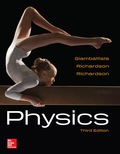
(a)
Whether
(a)
Answer to Problem 29P
Aluminum has larger buoyant force when it is immersed in water, since for the same mass aluminum is less dense and has larger volume than lead.
Explanation of Solution
Buoyant force is the force acting on object that is partially or completely immersed in water. Buoyant force is equal to weight of the water displaced by the object. Water displaced by the object depends on the volume of the object. Therefore, buoyant force is large for an object having larger volume than small volume.
Conclusion:
Lead is denser than aluminum. Therefore, for same mass lead has small volume than aluminum. Aluminum displaces more water than lead. Therefore, buoyant force will be larger for aluminum than lead.
Therefore, Aluminum has larger buoyant force when it is immersed in water, since for the same mass aluminum is less dense and has larger volume than lead.
(b)
Whether
(b)
Answer to Problem 29P
Steel is denser than wood. Since their masses are same volume is larger for wood than steel. Since floating wood displaces more water than sinking steel. Buoyant force is larger force wood that is floating than steel that is sinking.
Explanation of Solution
Buoyant force is the force acting on object that is partially or completely immersed in water. Buoyant force is equal to weight of the water displaced by the object. Water displaced by the object depends on the volume of the object. Therefore, buoyant force is large for an object having larger volume than small volume.
Conclusion:
Steel is denser than wood. Since both have same mass, volume of wood is larger compared to steel. Even though the wood is floating, it displaces more water than does steel. Buoyant force is equal to weight of the water displaced. Therefore, wood has larger buoyant force than steel, since water displaced by wood that is floating is larger compared to steel that is sinking.
Therefore, steel is denser than wood. Since their masses are same volume is larger for wood than steel. Since floating wood displaces more water than sinking steel. Buoyant force is larger force wood that is floating than steel that is sinking.
(c)
Find quantitative answers for part (a) and part (b).
(c)
Explanation of Solution
Buoyant force is equal to weight of the water displaced by object.
Write the expression for buoyant force.
Here,
Substitute
Here,
Similarly, write the expression for buoyant force acting on Aluminum.
Here,
Similarly, write the expression for buoyant force acting on steel.
Here,
Since wood is floating, its buoyant force is equal to its weight.
Calculate weight of wood.
Here,
Conclusion:
Substitute
Substitute
Substitute
Substitute
From above equations,
Therefore, buoyant force is larger force wood that is floating than steel that is sinking and Aluminum has larger buoyant force than lead.
Want to see more full solutions like this?
Chapter 9 Solutions
Physics
- 3aarrow_forward44 please help with the this.arrow_forward4a Which of the following values COULD NOT be a magnitude? Choose all that apply. 626 0 -0.806 8.63 -48.5 72 131 156 4b Px = -1248 & Py = 261. Determine P.P = Qx = -1540 & Qy = 375. Determine Q.Q = 4c. T = 1105 & Ty = 425. Determine the two possible values for Tx. 4d. Uy = -38. Which of the following COULD NOT be the value of U? Choose all that apply. 10 70 72 31 47 0 75 38 4e. R has a magnitude of 165. Which of the following COULD be Rx? Choose all that apply. 165 -171 155 0 -156 -165 172 -130arrow_forward
 College PhysicsPhysicsISBN:9781305952300Author:Raymond A. Serway, Chris VuillePublisher:Cengage Learning
College PhysicsPhysicsISBN:9781305952300Author:Raymond A. Serway, Chris VuillePublisher:Cengage Learning University Physics (14th Edition)PhysicsISBN:9780133969290Author:Hugh D. Young, Roger A. FreedmanPublisher:PEARSON
University Physics (14th Edition)PhysicsISBN:9780133969290Author:Hugh D. Young, Roger A. FreedmanPublisher:PEARSON Introduction To Quantum MechanicsPhysicsISBN:9781107189638Author:Griffiths, David J., Schroeter, Darrell F.Publisher:Cambridge University Press
Introduction To Quantum MechanicsPhysicsISBN:9781107189638Author:Griffiths, David J., Schroeter, Darrell F.Publisher:Cambridge University Press Physics for Scientists and EngineersPhysicsISBN:9781337553278Author:Raymond A. Serway, John W. JewettPublisher:Cengage Learning
Physics for Scientists and EngineersPhysicsISBN:9781337553278Author:Raymond A. Serway, John W. JewettPublisher:Cengage Learning Lecture- Tutorials for Introductory AstronomyPhysicsISBN:9780321820464Author:Edward E. Prather, Tim P. Slater, Jeff P. Adams, Gina BrissendenPublisher:Addison-Wesley
Lecture- Tutorials for Introductory AstronomyPhysicsISBN:9780321820464Author:Edward E. Prather, Tim P. Slater, Jeff P. Adams, Gina BrissendenPublisher:Addison-Wesley College Physics: A Strategic Approach (4th Editio...PhysicsISBN:9780134609034Author:Randall D. Knight (Professor Emeritus), Brian Jones, Stuart FieldPublisher:PEARSON
College Physics: A Strategic Approach (4th Editio...PhysicsISBN:9780134609034Author:Randall D. Knight (Professor Emeritus), Brian Jones, Stuart FieldPublisher:PEARSON





